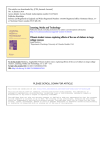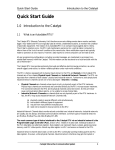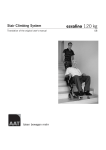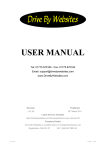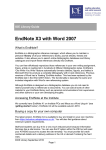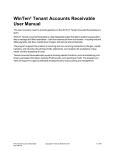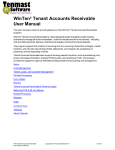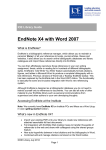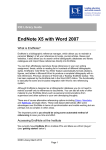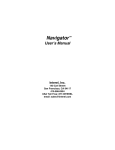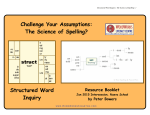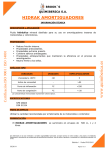Download PLEASE SCROLL DOWN FOR ARTICLE
Transcript
This article was downloaded by: [Simmons College] On: 15 September 2009 Access details: Access Details: [subscription number 906167225] Publisher Routledge Informa Ltd Registered in England and Wales Registered Number: 1072954 Registered office: Mortimer House, 37-41 Mortimer Street, London W1T 3JH, UK College & Undergraduate Libraries Publication details, including instructions for authors and subscription information: http://www.informaworld.com/smpp/title~content=t792303993 Re-Thinking the Library Pathfinder Jim M. Kapoun a a Reference Librarian, St. Mary's College of Maryland, St. Mary's City, MD, 20686, Online Publication Date: 21 April 1995 To cite this Article Kapoun, Jim M.(1995)'Re-Thinking the Library Pathfinder',College & Undergraduate Libraries,2:1,93 — 105 To link to this Article: DOI: 10.1300/J106v02n01_10 URL: http://dx.doi.org/10.1300/J106v02n01_10 PLEASE SCROLL DOWN FOR ARTICLE Full terms and conditions of use: http://www.informaworld.com/terms-and-conditions-of-access.pdf This article may be used for research, teaching and private study purposes. Any substantial or systematic reproduction, re-distribution, re-selling, loan or sub-licensing, systematic supply or distribution in any form to anyone is expressly forbidden. The publisher does not give any warranty express or implied or make any representation that the contents will be complete or accurate or up to date. The accuracy of any instructions, formulae and drug doses should be independently verified with primary sources. The publisher shall not be liable for any loss, actions, claims, proceedings, demand or costs or damages whatsoever or howsoever caused arising directly or indirectly in connection with or arising out of the use of this material. Re-Thinking the Library Pathfinder Downloaded By: [Simmons College] At: 00:50 15 September 2009 Jim M. Kapoun ABSTRACT. Pathfinders help library patrons find information, learn about library resources and physical space, and develop research strategies. They can be poorly constructed, excessively detailed, and inconsistently formatted. Some cover too many topics and include forced research strategies that make them difficult to read. This article offers a format and construction guide to aid librarians in preparing readable, useful pathfinders. KEYWORDS. Pathfinder, pathfinder format, pathfinder instruction, construction of pathfinders Jim M. Kapoun (MDIV, Luther Seminary St. Paul, MN; MLS, University of Wisconsin-Madison) is Reference Librarian at St. Mary’s College of Maryland, St. Mary’s City, MD 20686. College & Undergraduate Libraries, Vol. 2(1) 1995 E 1995 by The Haworth Press, Inc. All rights reserved. 93 94 COLLEGE & UNDERGRADUATE LIBRARIES Well-constructed pathfinders can provide support for reference service and bibliographic instruction. They supplement and organize bibliographic information, reinforce development of appropriate search strategies, and provide knowledge of basic library services. A good definition comes from Charles H. Stevens’s (et al.) article on pathfinders: Downloaded By: [Simmons College] At: 00:50 15 September 2009 The Library Pathfinder is a kind of map to the resources of the library; it is an information locator for the library user whose search for recorded materials on a subject of interest is just the beginning. A compact guide to the basic sources of information specific to the user’s immediate needs, it is a step-by-step instructional tool that will, if followed, place before the user those items that the most skilled reference librarian would suggest as basic to an initial investigation to the topic. (Stevens 1973, 41) Pathfinders are readily available in public service areas. Librarians use them liberally in instruction and orientation classes and to help answer general reference questions. Frequently, however, they are underused or out-of-date and end up as scrap paper or great tools for killing spiders. Although pathfinders are useful as instructional or reference tools, they can fall short of Stevens’s goal because of their purpose, format, use, scope, and readability. DEFINITION AND PURPOSE According to Stevens, pathfinders should include a map, an information locator, and subject headings appropriate for an initial investigation of a topic (Stevens 1973, 41-42). Pathfinders should direct patrons to all types of information on a particular subject by listing not only subject headings, but also indexes, abstracts, and relevant supplemental materials (Breivik 1982, 76-77). Basically, well-constructed pathfinders have two key elements: compactness and basic informational resources. Many pathfinders include multiple-pages of exhaustive information with extensive bibliographies. Such bibliographies are useful tools for research. They provide resources to perform in-depth Jim M. Kapoun 95 investigation, guide users through complex search methods, and illustrate appropriate resources. They are not, however, pathfinders. Pathfinders are not exhaustive guides to the literature. They are not accession tools. They are not bibliographies. Pathfinders are designed for beginners who need help finding the fundamental literature of a subject (Stevens 1973, 41). Downloaded By: [Simmons College] At: 00:50 15 September 2009 FORMAT Pathfinders can vary in design and format. Accordingly, this section does not provide specific instructions for writing a pathfinder. Guidelines for a universal format and a sample pathfinder are in Appendix A and B, respectively. What follows instead are general considerations to make pathfinders more effective. Establish a consistent format and content. The first rule is consistency. Use the same design for all the pathfinders that the library produces. Some pathfinders have no location codes. Others lack information about finding information in a catalog, an index, or a government document. Some list relevant subject headings. Some do not. The front side of a history guide lists resources, while the front of a psychology guide lists journals. Having a consistent format will: S create a blueprint to help mass produce pathfinders on many subjects; S provide continuity to each guide; and S ensure that major resource areas and tools (i.e., catalogs, indexes, journals, etc.) are listed. Select a format that is easy to follow and produce. Tailor the design to the library’s resources, budget, staff, and collection. The key is to construct a unified, consistent format consonant with current and future resources. Allocate sufficient staff time. It takes an experienced librarian eight to ten hours to prepare a pathfinder, or more if the pathfinder is significantly longer (Thompson 1985, 224). With the increasing demands on librarians, the danger lies in producing pathfinders quickly, without careful planning. 96 COLLEGE & UNDERGRADUATE LIBRARIES One librarian expressed to me the following, ‘‘I do them (pathfinders) because I have to, but I do not really have the time or the know-how to make them really good.’’ To this I replied, ‘‘If you lack the time and knowledge, why do you HAVE to create them in the first place?’’ Most librarians I asked claim they ‘‘have to’’ produce them because it is part of their job, whether stated in a job description or not. Does this mean that everything in the library must be documented on a pathfinder, or that a sign of a busy or good librarian is the number of pathfinders s/he produces? Of course not. Before starting a pathfinder, ask several critical questions. Downloaded By: [Simmons College] At: 00:50 15 September 2009 S Am I required to make pathfinders? S Can I construct a good document in a timely manner? S Is a pathfinder necessary on this topic? In one library, staff construct pathfinders as an alternative to public service contact. While visiting a small college library, I stopped at the reference desk to ask a question. The librarian on duty said nothing and gave me a pathfinder to answer the question. After paging through the six-page guide (which took several minutes), I found the answer to my question, one that would have taken only seconds to answer at the reference desk. It probably took a librarian more than eight hours to produce the pathfinder. In this case, it was not time well spent. Pathfinders are NOT substitutes for human contact, no matter how busy one may be on the reference desk. USE Often, pathfinders are designed as guides for information gathering and include specific research steps. A study conducted at the University of Wisconsin-Eau-Claire in the mid-1980s found that many users thought pathfinders were unsatisfactory because they provided specific references to information and did not allow students to develop their own search strategies (Thompson 1985, 224-225). Pathfinders should not dictate a single ‘‘correct way’’ to perform topical research. Instead, they should facilitate individual styles of information gathering. Even if patrons have no developed style of research, a pathfinder’s purpose is to provide avenues of awareness. A pathfinder should offer suggestions, not formulas. Jim M. Kapoun 97 There can be a danger in using pathfinders in bibliographic instruction classes. What message is sent to a class when the instructor grabs twenty pathfinders from a display and distributes them? It may demonstrate a lack of preparation time that good bibliographic instruction requires. A specific user guide that is tailor made for each class assures students that the instructor cares and has spent time on preparation for the class. General pathfinders do not take the place of detailed user guides designed for course-specific instructional sessions. Downloaded By: [Simmons College] At: 00:50 15 September 2009 SCOPE AND READABILITY All documents are problematic to write, edit, and update (even on a computer). The first version, however, is only the beginning. Production is a continuous venture. Updating, reviewing acquisitions, and weeding are ongoing (sometimes monthly) processes. A major consideration in producing a pathfinder is the commitment to updating and revision. Select topics consistently. Producing several pathfinders on a current event may be counterproductive. Planning includes careful topic selection, with sensitivity to lasting value, academic/functional usefulness, and available resources. Evaluate scope. Consider production and the quantity needed. Produce a small test amount and monitor usage. An empty slot in the display case, however, does not guarantee a popular pathfinder. Librarians need to be observant and pay attention to how people physically use pathfinders (i.e., for research, scrap paper, or coasters) and notice how many end up in a waste basket or recycling bin. Define cost in terms of staff, time, and supplies. Time is a valuable commodity, especially for busy reference or instruction librarians. Time factors include the initial production, updating/revising, and evaluation of usefulness. Supply expenses include paper, ink, and copying costs. Librarians should challenge themselves with questions on conservation of resources and the environment. Production in alternative, non-paper media might be considered. Control the use of jargon. While library pathfinders are not easy to write, they sometimes are even harder to read. Lorna Peterson and Jamie Coniglio in their article on readability of pathfinders/user guides describe typical communication problems: ‘‘Library hand- 98 COLLEGE & UNDERGRADUATE LIBRARIES books, guides, pathfinders, are not easy to write or to read. Many things described in them are inherently complicated to explain’’ (Peterson 1987, 236). Terms such as ‘‘tracing,’’ ‘‘Boolean,’’ ‘‘bibliographic,’’ or ‘‘citation’’ need simple explanations. A pathfinder is only usable if the people reading it can understand and comprehend its language. Peterson and Coniglio conclude: ‘‘It only seems appropriate that locally produced library guides, so diligently prepared and universally prevalent, attain their purpose and be readable, effective materials for patrons’’ (Peterson 1987, 236). SUMMARY Downloaded By: [Simmons College] At: 00:50 15 September 2009 Pathfinders are an integral part of reference and instruction services. Because they entail much work and effort to produce, the impetus for producing them should not come from the pressure to produce or create them ‘‘just to create them.’’ Librarians need to weigh and consider all facets--production, format, construction, content, use, scope, and readability--before beginning. To conclude: A pathfinder is not : An exhaustive bibliography of primary access tools. A pathfinder is : A beginning map to library services and resources. A pathfinder’s purpose : Is to educate about the basic resources for select topics. A pathfinder’s format : Is simple and direct, not a substitute for human service or instruction. A pathfinder is used : To facilitate individual styles of performing research. A pathfinder’s scope : Is broad and is reviewed after the initial creation. A pathfinder must : Be easy to read and be evaluated by librarians and the public. The professional challenge of creating pathfinders is to provide documents that enhance reference or public service with clear, timely, and readable information. Jim M. Kapoun 99 QUICK BIB Breivik, Patricia. ‘‘Planning the Library Instruction Program.’’ Chicago: American Library Association, 1982. Peterson, Lorna and Jamie W. Coniglio. ‘‘Readability of Selected Academic Library Guides.’’ RQ 27 (Winter 1987): 233-239. Stevens, Charles H. et al. ‘‘Library Pathfinders: A New Possibility for Cooperative Reference Services.’’ College and Research Libraries 34 (January 1973): 41-46. Thompson, Glenn J. and Barbara R. Stevens. ‘‘Library Science Students Develop Pathfinders.’’ College and Research Library News 46 (May 1985): 224-225. Downloaded By: [Simmons College] At: 00:50 15 September 2009 APPENDIX A UNIVERSAL PATHFINDER FORMAT GUIDELINES The following is an example of a universal format that all types of academic libraries could use for pathfinders. Pathfinder Format Example I. Decide on ONE header (or title) for each document--for example: 1. User Guide to American History at ABC College 2. A Pathfinder to American History Resources II. In three to four sentences, provide a brief description of the resource subject. For example: Many resources are available for the study of American History in the ABC library. They cover books, indexes, government documents, periodicals, bibliographies, and pamphlets. This guide lists the resources to conduct research in American History. III. List appropriate tools to find Subject Headings. For example: Use The Library of Congress Subject Headings books to research subject headings for possible use in CATS (our on-line 100 COLLEGE & UNDERGRADUATE LIBRARIES catalog), or in indexes. They are on the tables where CATS is located--main floor left of circulation desk. IV. Books 1. Describe your card catalog; give a brief statement on its use. For example: CATS is our computer card catalog. At the flashing cursor [-->] type in author, title, or subjects: (e.g.) au Jefferson, Thomas, ti The war of 1812, sub Vietnam conflict. CATS is located to the left of the circulation desk and PRESS F1 for on-line HELP or consult the User’s Manual to the right of each CATS terminal. 2. Prepare a representative list of core reference titles including: encyclopedias, dictionaries, handbooks, bibliographies, atlas, etc. Give the physical location and call numbers of the materials. Downloaded By: [Simmons College] At: 00:50 15 September 2009 V. Periodicals 1. Indexes and Abstracts a. Describe what an index is and the basic components of a citation. For example: An index is a listing of citations that direct you to specific articles in journals. A basic entry includes: author, title of the article, title of the journal, volume, number, date, and pages. b. List relevant indexes and abstracts to the subject, give a brief explanation and locations. For example: America History and Life is an abstracted index to articles, books, book reviews, and dissertations. It is located on index table 4, main floor in the Periodicals Area. (You may want to insert a brief guide to its use here.) 2. Periodicals, Magazines, and Journals a. Give a representative list of journals on your covered subject. For example: List journal name, a brief description, call number, and library holdings/format. Jim M. Kapoun 101 VI. Special Features 1. Include the possible use of government documents, maps, atlases, pamphlets, etc. For example: The Pamphlet File contains several subjects relevant to the Civil War. Consult the ‘‘Pamphlet File Subject Guide’’ for appropriate subjects. The Pamphlet File is located to the right of the reference desk in ten file drawer cabinets. 2. Some guides could incorporate a library physical map detailing locations. Placement of the map could be here or at the beginning, but should be consistent for all user guides. VII. Include contact people/library department(s) complete with phone and office numbers and physical location. Always list library operation hours and any relevant service information. Downloaded By: [Simmons College] At: 00:50 15 September 2009 APPENDIX B SAMPLE PATHFINDER The following is an example of a Pathfinder using the guidelines in Appendix A. MIDWEST STATE COLLEGE LIBRARY USER GUIDE TO WOMEN STUDIES RESOURCES Introduction to WOMEN’S STUDIES RESOURCES at the library Women’s studies is a comprehensive study of women in history, society, science, business, politics, sports, and literature. Doing any research on Women’s studies in the library requires patience and precise subject categories. This guide will help locate and begin an investigation on women’s studies covering books, indexes, periodicals, bibliographies, and pamphlets. SUBJECT HEADINGS To develop subject ideas consult the Library of Congress Subject Headings volumes. This large 4 set volume lists subject headings that you can use in our card catalog and various indexes. By using these volumes you can determine the precise heading under which information your subject can be searched. 102 COLLEGE & UNDERGRADUATE LIBRARIES Key to the codes -- > USE = look under the subject listed UF = used for (a subject substitute) BT = broad term, broaden the subject NT = narrow term (narrows the subject) RT = gives related subjects SA = see also another subject LOCATION -- > To the right of the REFERENCE DESK on the Table marked LC SUBJECT HEADINGS. BOOKS CATS is our computer card catalog. CATS searches by Author, Title, and Subject. At the flashing cursor [-->] type in the author, title, or subjects, see examples. Downloaded By: [Simmons College] At: 00:50 15 September 2009 --> au tan, amy (last name first) --> ti the joy luck club --> su women social conditions (from LC Subject Headings) LOCATION --> To the left of the Circulation Desk on the Tables marked CATS. HELPFUL HINT: Press F1 for on-line help or consult the USER’S MANUAL to the right of each CATS terminal. REFERENCE MATERIAL The following is a small sample of reference material that may help you in finding and defining the field of women’s studies. Literature Guides: Call Number Item Ref Z7964 .F44 L63 1987 Women’s Studies: a recommended core bibliography, 1980-1985. A listing of books that deal with women’s studies and issues from the dates listed above. Ref Z7964 .U49 R4 Women of Color in the United States, a guide to the literature. Covers major areas on women’s studies while exploring African, Asian, Hispanic, and Native American women. Jim M. Kapoun 103 Bibliographic Guides Ref PS151 .M54 1991 Modern American Women Writers The volume brings together critical and biographical essays of 41 representative women writers who have published in the U.S. since the 1870s. Ref CT100 .C8 Current Biographical Yearbook Presents articles on people who are prominent in the news (national and international), sciences, art, labor, and industry. Downloaded By: [Simmons College] At: 00:50 15 September 2009 Encyclopedias, Handbook, Dictionaries Ref G1201 .E1 G5 1985 Women’s Atlas of the United States This resource outlines the major subject of sociology to economics involving women in America. Informative maps and text chart aspects of daily life for women in America. Ref HQ1115 .W645 1989 Women’s Studies Encyclopedia This 3 volume set covers various aspects of women and the American experience. It incorporates feminist approaches and opinions. Ref HQ1420 .C55 1987 Statistical Handbook on Women in America This almanac covers the day-to-day events and accomplishments that comprise women’s history in the 20th century. LOCATION --> All of these listed are located in the REFERENCE SECTION which is directly behind the REFERENCE DESK. HELPFUL HINT: This list is a small representation of titles we own. Check CATS for complete listing or browse the shelves around the call numbers listed above. INDEXES AND ABSTRACTS An index or abstract (index plus journal summary) is a listing of citations that direct you to specific journal articles. SPECIFIC JOURNAL ARTICLES WILL NOT BE FOUND IN CATS. A basic entry includes: 104 COLLEGE & UNDERGRADUATE LIBRARIES author, title of the article, title of the journal, volume, number, date, pages. Indexes and Abstracts ABI-Inform located on any Index Computer station behind the CATS computers. --use for information about women and business, 1987-to date Humanities Index located in the INDEX AREA directly behind the Index Computer Stations. --use for information about women in the humanities, 1974-to date Periodical Abstracts located on any Index Computer station behind the CATS computers. --use for general information about women, 1987-to date located in the INDEX AREA directly behind the Index Computer Stations. --use for general information about women, 1890-to date Downloaded By: [Simmons College] At: 00:50 15 September 2009 Reader’s Guide Social Science Index located on any Index Computer Station behind the CATS computers (1989-to date) AND located in the INDEX AREA directly behind the Index Computer Stations (1965-to date) --use for social science information on women REPRESENTATIVE TITLES OF JOURNALS Feminist Studies Graduate Women --v.19 (1993)-to date --v.79 #4 (1985)-v.82 #5 (1988) changed to OUTLOOK --v.83 (1989)-to date --microfilm v.6 (1981)-to date --v.15 (1989)-to date Outlook Psychology of Women Quarterly Sign: A Journal of Women in Culture and Society LOCATION--> The current year of all journals are located on the main floor in the EAST WING (follow signs from Reference Desk). Back issues are located on the GROUND FLOOR. Microfilm is located on the main floor in the East Wing. Jim M. Kapoun 105 PAMPHLETS The Pamphlet File is an excellent place to look at recent information on Women’s issues. Consult the Red Index Binder and look for your subject, in this case look under WOMEN. LOCATION --> The PAMPHLET FILE is to the right of the REFERENCE AREA in 7 file cabinets. The Red Index Binder is located on the desk to the left of the file cabinets. HELP! HELP! Downloaded By: [Simmons College] At: 00:50 15 September 2009 When in doubt always ask the library staff. HOURS(SEMESTER): M-TH 8:00AM-11:00PM Friday 8:00 AM-5:00PM Sat. NOON-8:00PM Sun. NOON-11:00PM HOURS (SUMMER/INTERSESSION) M-F 8:00AM-5:00PM IMPORTANT NUMBERS: Reference Desk 222-4545 Reference Librarians Joe Abram 222-0234 Sue Jones 222-0235 Betty Smith 222-0236 Circulation Desk 222-4040














